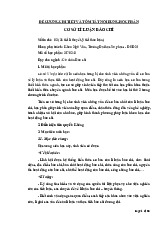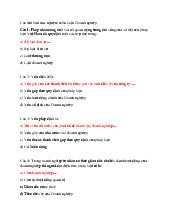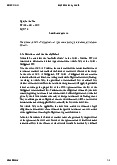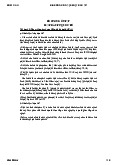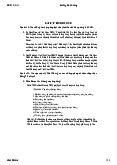












Preview text:
22:56 2/8/24
Luật Biển QT - TT2 - Summary Luật quốc tế
Nhóm 1: The Process of Making Article 121, Opinions Contributed and State Practice
A. The Process of Making Article 121 and Opinions Contributed
I. Before the UN Convention on the Law of the Sea
1. The Hague Conference for the Codification of International Law (1930)
At the earliest stage, the 1930 League of Nations Codification Conference at the
Hague was the first time to define the notion of an island in customary law. The first
regime of islands in the Final Act of the 1930 Conference was concluded as:
Every island has its own territorial sea. An island is an area of land, which is
permanently above high-water mark.
As a result of that, all high-tide elevations were considered as an island. In other
words, there was no categorization between islands and rocks. This was the primary
defined norm of islands introduced in 1930.
2. The 1956 International Law Commission Report
The commentary in the report of the ILC to the General Assembly (United Nations,
1956) described that a different phrase should be added, which was “in normal circumstances”.
Every island has its own territorial sea. An island is an area of land, surrounded by
water, which in normal circumstances is permanently above high-water mark. about:blank 1/13 22:56 2/8/24
Luật Biển QT - TT2 - Summary Luật quốc tế
The commentary on the section of Article 10 defines an island as "any area of
land surrounded by water which, except in abnormal circumstances, is
permanently above high-water mark." According to this definition, artificial land
is also considered to be an island. This means that, until Article 10 of the
Convention on the Territorial Sea and the Contiguous Zone of 1958 restricted the
definition of an island to a naturally formed area of land, there had been a legal
interpretation enabling land that did not form naturally to possess its own territorial waters.
II. From UNCLOS I to UNCLOS III
1. The 1958 Geneva Conventions on the Law of the Sea
The First Conference produced four conventions: -
the Convention on the Territorial Sea and the Contiguous Zone (CTS); -
the Convention on the High Seas (CHS); -
the Convention on Fishing and Conservation of the Living Resources of the High Seas (CFCLR); -
and the Convention on the Continental Shelf (CCS).
Article 10 of the first Conv and Article 1 of the fourth one established the following rules on islands:
In this stage, a definition of islands was formed the same as the present phrases, “a
naturally-formed area of land, surrounded by water, which is above water at high tide.”
By that, these Conventions considered any elevations which are above water at high tide as islands.
However, another argument of a definition of rocks was still discussed.
Furthermore, although the definition of islands was formatted the same as the current
one in 1958, it was still a concern to divide high-tide elevations into categories of
marine entitlements qualified or unqualified islands.
All delegations acknowledged that the 1958 Convention island definition articles
were vague but no consensus was found on how to formulate general rules that all
delegations could accept as a substitute for the 1975 text given the widely diverse
factual situations regarding islands around the world.
Article 121 was an attempt to accommodate essentially irreconcilable positions.
For the objective definition proponents, the most influential “spokesmen” were
members of the Organization of African Unity (OAU). The OAU delegates
advocated the need to define islands, and thereby fix maritime entitlement using
objective factors. This group of States recommended that such determinations be about:blank 2/13 22:56 2/8/24
Luật Biển QT - TT2 - Summary Luật quốc tế
based on equitable principles considering all relevant factors and special circumstances including: (a) the size of islands;
(b) their population or the absence thereof;
(c) their contiguity to the principal territory;
(d) their geological configuration;
and (e) the special interests of island States and archipelagic States.
The OAU delegates’ approach was also at odds with States that preferred the
existing law with its imprecise definitions in article 10 of the Convention on the
Territorial Sea and the Contiguous Zone or even with no definition at all, as was
the case in the text of article 1 of the Convention on the Continental Shelf.
2. United Nations Committee on the Peaceful Uses of the Sea-Bed (The
Seabed Committee, 1968-1973)
The genesis of Art. 121 (2) and (3) is inextricably linked with the expansion of coastal
State jurisdiction through the exclusive economic zone and the continental shelf. The
question of the maritime entitlements of islands was first discussed in the Committee
on the Peaceful Uses of the Sea-Bed and the Ocean Floor beyond the Limits of
National Jurisdiction (‘Sea-Bed Committee’) which was working on a draft
declaration of legal principles governing the sea-bed and the ocean floor, and the
subsoil thereof, beyond the limits of national jurisdiction. On 18 March 1969, Malta
submitted a draft declaration which recommended that ‘rocks and islands
without a permanently settled population’ should be disregarded when
determining the coastal States’ right to exercise sovereign rights over the
resources adjacent to their coasts. Several States immediately objected. The
battle lines for the coming years were drawn. Matters were further complicated when
at UNCLOS III questions of delimitation of the maritime zones of islands close to the
coast of another State entered the picture. The various provisions taken by States are well documented.
In the 1972 subcommittee meetings of the UN Sea-Bed Committee, several countries
expressed their opinions on the question of the regime of islands, concerned the
exclusive economic zone, as well as the regime of islands under foreign domination
and control in relation to zones of exclusive fishing jurisdiction, mentioned above as a
major issue. In response to those concerns, a variety of differing options were studied,
such as whether to grant the same status to all islands, and whether to categorize
islands differently based on standards involving their size, location, population, or
ocean space associated with them. about:blank 3/13 22:56 2/8/24
Luật Biển QT - TT2 - Summary Luật quốc tế
In the 1973 Sub-committee, the term for rock was introduced for the first time.
The African Unity proposed the definition of rock as follows:
A rock is a naturally formed rocky elevation of ground, surrounded by and
above water, which is above water at low tide.
From this proposed definition, a rock was considered as a maritime rocky feature under the group of islands.
-> It was clearly separated into two parties when the committee concluded. One was
a group who claimed to take various and special circumstances of each island into
account. The other group held a claim that equal treatment for islands was important. III. UNCLOS III
1. Second session (The Caracas session in 1974)
Four main proposals were raised by parties in the negotiation in Caracas, 1974 to
discuss the regime of islands. The issue was about arguments regarding equal
versus individual treatments on islands.
Furthermore, the original stipulation of a rock’s marine entitlement was formed in 1974. The definition was:
Rocks which cannot sustain human habitation or economic life of their own shall
have no exclusive economic zone or continental shelf.
2. Third session (The Geneva session, 17 March to 9 May 1975)
The Conference mandated the chairs of the three main committees to produce what
were known as the Informal Single Negotiating Texts.
The various provisions about the delimitation of the maritime zones of islands close to
the coast of another State taken by States are well documented. However, the text of
Article 121 (2) and (3) emerged from informal consultations during the Third Session
of UNCLOS III in 1975 for which there are no official records. In the words of the
President of UNCLOS III As well as the official negotiation process, a number of
unofficial negotiating groups operated on the sidelines of the Conference, contributing to its success.
The present text of the provision appeared first on the 9th of May 1975 as Article
132 of the Informal Single Negotiating Text (ISNT) about:blank 4/13 22:56 2/8/24
Luật Biển QT - TT2 - Summary Luật quốc tế
3. Final session (The New York Session in 1982)
Like the proposals above, some attempts were conducted in this final session, from the UK and Romania.
During the Fourth Session of UNCLOS III in 1976 several amendments were
suggested which commanded strong, but not majority, support. The provision was
therefore retained without change in Article 128 of the Revised Single Negotiating
Text. During the remainder of the conference several attempts were made, on the one
hand, to limit the maritime entitlements of islands even further and, on the other, to
remove any restriction of islands by deleting paragraph 3 altogether.
No further changes were eventually agreed for Article 121 from 1979 to 1982.
Thus, Article 121 was adopted as a regime of island in 1982. Art. 121 was
regarded as including ‘a certain progressive development’ of the rules of the 6
1958 Geneva Conventions on the Law of the Sea. The islands were defined in
article 121(1) and the criteria of entitled rocks was shown in Article 121(3). Thus, the
negotiation history showed there were concerns and warnings to limit states’ self-
beneficial claims before making a definition. Although some attempts to introduce
limitation of qualification of islands or to make terms clearer were discussed, the
ambiguity of Article 121 has remained as a result from different interests of coastal states. about:blank 5/13 22:56 2/8/24
Luật Biển QT - TT2 - Summary Luật quốc tế
IV. Opinions contributed during the process of making Article 121
The two most authoritative supplementary sources to research the context of Article
121 are A Legislative History of Part VIII (8) (Article 121) of the United Nations
Convention on the Law of the Sea published in 1988 by the UN Office for Oceans
Affairs and the Law of the Sea and United Nations Convention on the Law of the Sea
1982, A Commentary, the relevant volume of which was published seven years after the UN Study in 1995.
In these sources, Iran recorded an interesting interpretation as its “understanding”:
Islets situated in enclosed and semi-enclosed seas which potentially can sustain
human habitation or economic life of their own but, due to climatic conditions,
resource restriction or other limitations, have not yet been put to development, fall
within the provisions of paragraph 2 of Article 121 concerning ‘Regime of Islands’,
and have, therefore, full effect in boundary delimitations of various maritime zones of
the interested coastal States.
This understanding comports with the conclusions in the comments of Rapporteur
Nandan, the principal draftsman of Article 121(3). Thus, the broad parameters of the
future debate concerning status, maritime entitlement and the legal consequences from
islands were already framed by the end of the 1973 session of the SeaBed committee.
During the same session, some member states also produced their own draft
convention texts, either individually or in concert with other members. During
deliberations on the regime of islands, several drafts were submitted. These included
the Malta Draft, the Greek Draft, the Uruguay Draft, and the 14 African Nation Draft.
The “Draft Ocean Space Treaty,” submitted by Malta, deserves particular attention.
Part I (Ocean Space), Chapter I (Definitions), Article 1: The term island is used as
referring to a naturally formed area of land, surrounded by water, which is above
water at high tide. The text starting with “a naturally formed ...” was used as-is in the
definition of an island found in Article 10 of the 1958 CTS (which also employs the
following wording in Article 11, Part 1): “A low tide elevation is a naturally formed
area of land which is surrounded by and above water at low tide but submerged at
high tide.” Part II (Coastal State Jurisdiction in Ocean Space), Chapter IX (Limits),
Article 37 contains rules for the jurisdiction of island or archipelagic states. According
to this clause, the jurisdiction of a state extends 200 nautical miles from the principal
island or islands, or over a belt of ocean space 200 nautical miles from other islands.
The principal island or islands can be designated by that state, and such designations
shall be notified to the International Ocean Space Institutions, which have authority
over such designations. Part V (The International Ocean Space Institutions: IOSI),
Chapter XVI (Establishment and personality) Article 90: The Institutions may accept about:blank 6/13 22:56 2/8/24
Luật Biển QT - TT2 - Summary Luật quốc tế
from any State the transfer to their administration of reefs, sandbanks, or islands
having less than 10,000 permanent inhabitants. This approach was based on the stance
that a small island nation may lack resources sufficient for the safeguarding and
development of the ocean, and that such island nations should have jurisdiction over only small areas. Conclusion
The Regime of Islands text was carefully scrutinized and reviewed at the Third
Conference. The text that survived intact as first drafted in 1975 was an imperfect
compromise with deliberate ambiguity that nevertheless was ultimately adopted by the Conference.
Article 298 of UNCLOS was also primarily a political compromise between those
States that tended to favor compulsory dispute settlement as a residual rule for
virtually all issues and those that would not agree to empower third parties to
judge sea boundary disputes, military activities or second guess coastal State
enforcement actions in the EEZ.
Another political compromise was served by 121(3) which papered over the
differences between the geographically disadvantaged/landlocked States and
developing mid ocean island States. which included Germany, Netherlands, and Poland.
Following years of intense and unsuccessful negotiations, imperfect wording with
deliberate ambiguities was included in the final text of the Convention and that is what
Article 121 contains. The working premise at the end for largely exhausted delegates
at the Third Conference was that imperfect solutions were better than no solutions at
all. The reality all were trying to serve was the necessity to reach the goal of a
consensus agreement. The task was almost impossible for there really was no
perfect middle ground between those States that wanted a median line solution
for all islands involved in delimitation disputes and those that wanted “special
circumstances” to achieve their perceived equitable result. B. STATE PRACTICE Case 1: Rockall Dispute * Overview:
The legal issues surrounding the remote Atlantic rock of Rockall have been a long-
standing saga for Ireland, centring on what maritime zones such a minuscule1 and
distant insular formation may generate. They have progressively escalated from an about:blank 7/13 22:56 2/8/24
Luật Biển QT - TT2 - Summary Luật quốc tế
essentially bilateral dispute between the UK and Ireland to what is now a major
quadrilateral dispute between the UK, Ireland, Denmark (on behalf of the Faeroes)
and Iceland, and involving issues on seabed rights which no longer remain
realistically linked to the effect of mere ownership of the rock.
In the light of this, and the fact that since the ‘Rockall dispute’ originated, the
UNCLOS 1982 has deprived through Article 121(3), uninhabitable and economically
worthless “rocks” of the capacity to generate continental shelf or 200-mile EEZs (or
fishery zones) for the owner State, it is not surprising that British claims to continental
shelf in the Rockall region increasingly tended to emphasize an alternative basis of
claim – namely that the Rockall Plateau and its environs were a natural prolongation
of the Scottish landmass. And, indeed despite some possible Irish interpretations to the
contrary, the UK did not rely on Rockall relative to neighboring States for median line
purposes in its 1974 continental shelf designation in the Rockall Region. * Arguments of UK: ● Before
- The 1996 British statement announcing postponement of any British accession to the
UNCLOS, because of the threat to Rockall’s status under that convention, was largely
of academic interest in terms of the seabed (continental shelf) claims in the Rockall region.
- The 1996 British Statements on the Rock Based Fishery Zone, UK mentioned that
the “Rockall fisheries” was a matter of concern to the UK and that this was why the
UK was “continuing to study the legal implications to make sure that things were right.
- In the past situation, this aspect of the ‘Rockall dispute’ which most directly hinged
upon the status of the rock itself, as without the aid of the rock as a basepoint, the UK
could make no 200-mile fishery zone claims in the North Atlantic beyond existing
mainland-oriented or off-shore Scottish island base points. In other words, Rockall has
been vital to further expansion of British 200-mile fishery limits – far beyond that
generated by the Scottish shoreline or its off-shore islands (including the far-flung St
Kilda); and up to 1997, the UK has consistently upheld Rockall’s entitlement in its
own right to generate such a zone. ● After:
- Compliant state practice can be seen from an example that in 1997, after the United
Kingdom ratified UNCLOS, it redefined the fishery limit off Rockall of 200 nautical
miles from the stipulation in the Fishery Limit Act of 1976.
- This became evident from a parliamentary answer by the British Foreign Secretary,
Robin Cook in the House of Commons on 21 July 199790 when he announced the
new British Government had “decided to accede” to the UNCLOS later that month.
But he added this important rider: The United Kingdom’s fishery limits will need to
be redefined based on St Kilda, since Rockall is not a valid base point for such limits
under Article 121(3) of the Convention. about:blank 8/13 22:56 2/8/24
Luật Biển QT - TT2 - Summary Luật quốc tế
Case 2: Arbitration between the Republic of the Philippines and the People’s Republic of China * Overview:
On 12 July 2016 the Merits Award of the Sino-Philippine Arbitration in the South
China Sea (SCS) Disputes was released. One of the most influential but controversial
rulings is the Tribunal’s interpretation of Article 121(3) of the United Nations
Convention on the Law of the Sea (UNCLOS). * Judgement of PCA:
- The judgment of PCA clarified the definition of the “islands”. It found that none of
the Spratlys- including Itu Aba, Thitu, Spratly Islands, Northeast Cay, and Southwest
Cay- are legally islands because they cannot sustain a stable community or
independent economic life. - Also, Scarborough Shoal, Johnson Reef, Cuarteron Reef,
Fiery Cross Reef, Gaven Reef (North), and McKennan Reef is a “ rock for the purposes of Article 121(3).
- In terms of, Johnson Reef, Cuarteron Reef, Fiery Cross Reef, Gaven Reef (North),
While China has constructed an installation and engaged in significant land
reclamation work at these reefs, this is only possible through dredging and the
elevation of the portion of the reef platform that submerges at high tide. With the other
high-tide features that have been the subject of construction and reclamation work, the
status of a feature for the purpose of Article 121(3) is to be assessed on the basis of its
natural condition, prior to human modification. China’s construction on these reefs,
however extensive, cannot elevate its status from rock to fully entitled island.
- About McKennan Reef The Tribunal finds that McKennan Reef includes a feature
that remains exposed at high tide and is accordingly a high-tide feature. There is no
indication that this feature is of any significant size, and the Tribunal concludes that
the height indicated on the recent Chinese chart most likely refers to a coral boulder
pushed above high water by storm activity. Such a feature would be obviously
incapable, in its natural conditions, of sustaining human habitation or an economic life
of its own. There is no evidence of any human activity on McKennan Reef, nor has
any State installed a human presence there.
Three importance point can be noted: -
First, the Tribunal used the generic term hightide feature (HTF) to describe a
feature meeting the definition of an island under Article 121(1), thus making
HTF interchangeable with island. Every HTF has to undergo the disqualifying
test provided by Article 121(3) before knowing whether the feature has
entitlements to an exclusive economic zone (EEZ) and continental shelf. This
divides the category of HTF into two categories, “rocks” and “fully entitled islands.” -
Second, “rocks” stand for those HTFs (or islands) that “cannot sustain human
habitation or economic life of their own” under Article 121(3), and, hence, are
incapable of generating an EEZ and continental shelf. -
Third, “fully entitled island” is HTF which is not a “rock” and therefore has an
EEZ and continental shelf. For an HTF to be a “fully entitled island,” it must
not meet either of the disqualifying conditions in Article 121(3).
* Arguments of the countries: about:blank 9/13 22:56 2/8/24
Luật Biển QT - TT2 - Summary Luật quốc tế 1. Philippines
* Arguments of Philippines before the judgment:
The Philippines submits that Scarborough Shoal and all of the high-tide features in the
Spratly Islands are properly characterized as “rocks” under Article 121(3) of the
Convention. Philippines’ arguments Ten points are summarized below:
- First, to determine the object and purpose16 of Article 121(3), the Philippines
invoked the “origins” of the provision and the “negotiating history,” in particular, the
“records of the Third United Nations Conference,” which, according to the
Philippines, reflected an “overwhelming opposition” to the prospect of granting very
small, remote, and uninhabited islands or tiny and insignificant features extensive
maritime zones. Otherwise, the maritime space of other States and the area of
international seabed would be unfairly and inequitably impinged upon.
- Second, the Philippines argued that the meaning of “rock” in Article 121(3) must not
be limited in terms of geological or geomorphological characteristics. Thus,
protrusions above water that are composed of coral, mud, sand, or soil may constitute
rocks under Article 121(3). The Philippines in its 2014 Memorial treated “rocks,”
“islands,” “insular features,” and “features” as interchangeable and identical.
- Third, the Philippines acknowledged that size alone is not determinative of the status
of a feature as a rock under Article 121(3). However, the Philippines invoked the
negotiating history and certain State practices to argue that an HTF of less than one
square kilometer could be presumed to be unable to sustain human habitation and economic life of its own.
- Fourth, the Philippines noted that the term “cannot” in Article 121(3) refers to the
capacity or potential of the feature to sustain human habitation or economic life.
- Fifth, the Philippines argued that the term “sustain human habitation” means that a
feature can “support a stable group of human beings across a significant period of
years” by providing fresh water, food and living space and materials for human
shelter. This interpretation is supported by the requirement that an island must be
“naturally formed” under Article 121(1).
- Sixth, the term “of their own” connected with features sustaining an economic life,
according to the Philippines, means “that the feature itself has the ability to support an
independent economic life without infusion from the outside.”
- Seventh, the term “economic life,” according to the Philippines, requires the feature,
in its naturally formed state, to have the capacity to be a source of production,
distribution, and exchange sufficient to support the presence of a stable human population.
- Eighth, the Philippines invoked various commentaries to argue that a military
presence on a feature, serviced from outside, does not establish that a feature is
capable of sustaining human habitation or has an economic life of its own. about:blank 10/13 22:56 2/8/24
Luật Biển QT - TT2 - Summary Luật quốc tế
- Ninth, while recognizing that the Case was not one of maritime delimitation, t he
Philippines suggested that the Tribunal seek guidance from the approach of
international courts and tribunals in the delimitation context. In the delimitation
decisions features of comparable nature, small size, and remoteness to those in the
Spratly Islands have all been enclaved and given no more than 12 nautical mile
territorial sea. Such enclaving was done to achieve an equitable result in drawing a
boundary line. According to the Philippines, in any future maritime boundary
delimitation in the South China Sea, all of the HTFs would be enclaved.
- Tenth, ultimately, the Philippines submitted that the test of whether a feature
constitutes a “rock” for the purposes of Article 121(3) involves a “question of
appreciation” in light of the natural characteristics of the feature and that it should be
an objective test in the sense that it should not be determined by a State’s subjective assertions.
=> The Philippines argues that the State practice on the interpretation of Article
121(3) is inconsistent, but States generally accept that small, uninhabited, barren
outcrops should not generate full maritime zones, citing in particular (a) the United
Kingdom’s renunciation of its 200-nautical-mile fishery zone around Rockall.
* Arguments of Philippines after judgment:
- Philippine Foreign Minister Perfecto Yasay said that the decision is a turning point,
which is an important contribution to the effort to resolve the dispute at sea. The
Philippines emphasized the commitment to pursue peaceful solutions and resolve
disputes with the viewpoint of pushing peace and stability in the region and calling for
all stakeholders to restrain and calm down. The Philippines affirms respect for this turning point.
- The Philippines and its experts submit that all four of the high-tide features identified
in its Submissions No. 3 and 7—Scarborough Shoal, Johnson Reef, Cuarteron Reef,
and Fiery Cross Reef—are indisputably Article 121(3) rocks.
- The Philippines concedes that the three largest features, Itu Aba, Thitu, and West
York, “differ from Scarborough Shoal, Johnson Reef, Cuarteron Reef, and Fiery Cross
Reef in terms of their area, natural conditions and small population”. According to the
Philippines, none of the features in the Spratly Islands is capable, based on its own
natural elements, of sustaining both human habitation and economic life of their own. 2. China
* Arguments of China before judgment:
- China rejected the Philippines’ submissions that the Tribunal examine the legal
status of nine China-occupied features as being unhelpful in determining China’s
maritime entitlements. China indicated that all the maritime features comprising the
Nansha Islands must be considered and that “based on the Nansha Islands as a whole,”
China has territorial sea, EEZ, and continental shelf.39 No position on the
interpretation or application of Article 121(3) respecting any of the features identified
in the Philippines’ Submissions was taken by China. about:blank 11/13 22:56 2/8/24
Luật Biển QT - TT2 - Summary Luật quốc tế
- China quoted the provisions of Article 121(3) and state and China argued that there
was a need for “some appropriate guidelines” on the issue of the legal implication of
Article 121 on the protection of the common heritage of mankind.
- China raised the issue of rocks under Article 121(3) in the context of particular
continental shelf submissions and “argued that the International Seabed Authority was
the right forum to discuss matter since it had the mandate to protect the common
heritage of mankind.”496 Referring to Article 121(3), the Chinese representative
“urged member States to be guided by the letter and spirit of the Convention to avoid
any encroachment on the common heritage of mankind.
- China stated that it “consistently maintains that, the rock of Oki-no-Tori, on its
natural conditions, obviously cannot sustain human habitation or economic life of its
own” and therefore under Article 121(3), the rock of Oki-no-Tori “shall have no
exclusive economic zone or continental shelf.” However, China did not state that an
high-tide feature or island incapable of sustaining human habitation or economic life
of its own was a rock and without EEZ and continental shelf.
- Through the statements recounted above, China has demonstrated a robust stance on
the importance of Article 121(3). It has repeatedly alluded to the risks to “the common
heritage of mankind” and “overall interests of the international community” if Article
121(3) is not properly applied to small features that on their “natural conditions”
obviously cannot sustain human habitation or economic life of their own. China has
not, however, assessed those factors in any specific analysis of most of the individual
features in the South China Sea, as discussed below.
* Arguments of China after judgment:
- Beijing on the expected lines severely criticized the judgment of the highest
international body on the grounds that raised eyebrows of most nations. Three aspects
of Chinese reactions deserve attention.
➔ First, China termed it as ‘null and void’ and stressed that there was no binding
force to impose the verdict upon China.
➔ Second, China challenged the jurisdiction of the Tribunal over the submissions made by the Philippines.
➔ Third, China blamed the Hon’ble Judges for impartiality by alleging that out of
five Judges, four were under the influence of Japan. Such a criticism from a
country that was signatory to UNCLOS was infelicitous.
- The reality is that China has brazenly refused to comply with the Award. UNCLOS
makes no provision for enforcement and so the status quo prevailed. Since the Award,
China has further consolidated its presence in the Spratlys by completing construction
on seven so-called “artificial islands” and militarizing them. The artificial islands
serve as foreign operating bases for China’s navy, coast guard, maritime militia, and fishing fleets.
=> The Arbitral Tribunal Award has never been complied with by China. about:blank 12/13 22:56 2/8/24
Luật Biển QT - TT2 - Summary Luật quốc tế References:
[1]https://vietnamlawmagazine.vn/islands-and-maritime-claims-in-the-south-china-
sea-illusions-of-or-intentional-dilution-of-international-law-3539.html
[2]https://vietnamnet.vn/tim-hieu-mot-so-an-le-ve-tranh-chap-chu-quyen-bien-dao- 420509.html
[3]https://www.academia.edu/35930308/
THE_SOUTH_CHINA_SEA_ARBITRATION_AWARD_OF_JULY_12_2016_THE
_UNBEARABLE_LIGHTNESS_OF_BEING_A_ROCK
[4] https://amti.csis.org/a-case-of-rocks-islands/
[5]https://www.rappler.com/newsbreak/iq/98839-philippines-china-hague-arguments- explanation/
[6]https://pca-cpa.org/en/cases/7/
[7]https://cil.nus.edu.sg/wp-content/uploads/2017/01/Session-3-on-Entitlement-of-
Rocks-and-Islands-Myron-Nordquist-Paper.pdf
[8]https://journals.seagullpublications.com/ijeer/assets/paper/IJ0420190738/ f_IJ0420190738.pdf
[9]https://www.spf.org/islandstudies/transfer/research/docs/a00010r.pdf
[10]https://www.spf.org/islandstudies/research/a00010.html
[11]https://commons.wmu.se/cgi/viewcontent.cgi?
article=2192&context=all_dissertations about:blank 13/13
